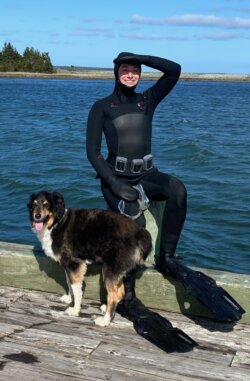An underwater survey to learn more about the marine ecosystem of the sanctuary waters
“You can’t see a whole lot from aerial photography,” Alexandra Vance explains. “You’ve really got to get in the water if you want to understand the health of the marine environment that the whales will be experiencing and interacting with.”

Alexandra is the Whale Sanctuary’s new project manager for Nova Scotia, and her expertise is especially valuable as we move toward completing the final environmental studies and submitting the results to federal, provincial and tribal authorities. The multiple studies we’ve been conducting over the past two years are all part of the rigorous and detailed process of permitting that’s required prior to construction.
In this case, Alexandra was conducting her first in-water field survey to advance our understanding of key areas in sanctuary waters and to identify species of marine vegetation. This time she was free diving, without scuba gear. In subsequent dives, she and dive team members will conduct more extensive surveys of sediment structure and size, shallows, depths, slopes and assess the marine vegetation throughout the whole 100 acres of sanctuary waters.
“What I wanted to understand most of all about the sanctuary environment,” Alexandra says, “was the general health of the marine flora and fauna. This includes how long lived some of the marine vegetation is.” Older growth would suggest that Barachois Island, which forms part of the sanctuary boundary, has been acting as a barrier and protector to the seabed behind the island. Newer growth suggests that there may have been some recent disturbance in this part of the bay. So, by observing the marine vegetation with regard to its health and longevity, we can see how well protected the overall environment is for the whales.
“The vegetation is very healthy, and the overall marine ecosystem has been well protected from natural disturbances like hurricanes.”What Alexandra found was, indeed, healthy, long-lived marine vegetation in most areas, along with some more recent younger and sparser marine vegetation in a few others, and some sandy banks close to shore. She also found lots of species like crabs, fish, sea stars and periwinkles. “That means the vegetation is very healthy,” she explains, “and that the overall marine ecosystem has been well protected from natural disturbances like hurricanes. And that’s primarily because it’s been well protected behind the island.”
Alexandra is especially well-suited to her work for the Whale Sanctuary. “I spent my childhood playing marine biologist on the shores of the Maritime provinces with the Atlantic Ocean all around. That’s what shaped my lifelong passion for marine science and conservation.” She went on to achieve a BSc with a double major in Biology and Environmental Sciences at Dalhousie University. And after that, for her master’s degree in marine management, she researched the relationship between eelgrass and bivalve aquaculture at various spatial scales. “It all gave me a special insight and appreciation for the complexity of local marine ecosystems.”
The updated information we gathered from this underwater survey is an essential part of our work with the Department of Fisheries & Oceans and with tribal authorities as part of the permitting process. It also helps us understand what the whales will experience in their new life at the sanctuary.
Although environmental surveys will always be a necessary aspect of our annual work, once permitting is completed, Alexandra will assist in coordinating the construction of the sanctuary net, the various buildings (animal care, veterinary, maintenance, etc.) and infrastructure.